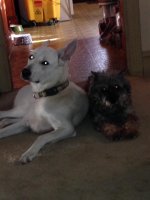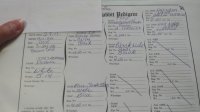- Thread starter
- #11
HaloRabbits
Loving the herd life
- Joined
- Mar 4, 2017
- Messages
- 140
- Reaction score
- 110
- Points
- 113
For Color genetics each combination of genes yeilds a specific phenotype. Phenotype is what you see. For example a REW has "cc" for sure, but that is all you can be sure of by just looking at the rabbits. Sometimes the pedigree can give you more information. For example my does mother was Blue, which means I know for sure she was "dd", so I know my doe would have at least one copy of "d", since she isn't a dilute I actually know she is "Dd". The more information you have on the parents the easier it is, but since I am just starting it is proving a little difficult. I am going to continue though, and the more breedings I do, I will have a better idea.@HaloRabbits how do you genotype your rabbits?
BTW my Huksy/Shepherd mix is ~50 pounds too.






